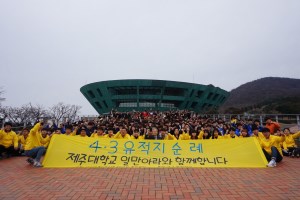
What is 4•3?
4•3 is the shortened term of 4•3 Incident or the April 3rd Jeju Uprising. On April 3, 1948, the Jeju Workers Party of South Korea started to rebel against the provisional South Korean government which at the time was supported by the U.S. military. From then on, the people of Jeju faced brutal suppression not only physically but psychologically.
From April of 1948 to May of 1959 around 14 to 30 thousand Jeju civilians were either killed in rebel rights or executed for showing support to Kim Il-Seong of North Korea and opposing the separation of the two Koreas. Villages were purged and burned to the ground, mass executions took place near the mountainous villages and it is still remembered today as the most tragic part of Jeju history.
What events led up to 4•3?
On August 15, 1945, after 35 years of Japanese occupation, the Korean peninsula found itself torn into two, with the North taken over by the Soviet Union and the South by the U.S. military government.
Upset by the partitioning of the peninsula, the Workers Party of South Korea held rallies on March 1, 1947 to denounce the South Korean Constitutional Assembly election that was scheduled to take place on May 10, 1948. The Jeju people also rallied by holding a 'Jeju Competition' to commemorate the 28th anniversary of Korean Independence Movement Day at Jejubuk Elementary School.

The people then took to the streets with protestors marching by the Gwandeokjeong Pavilion (the provincial government building at the time). When a mounted policeman’s horse trampled a child and the policeman did little to help, the passerby protestors cursed and threw rocks in anger at him.
In fear of the mob getting out of control, local police fired gunshots into the crowd which resulted in six people dead and eight critically injured.
In retaliation, on April 3rd, the Jeju Workers Party of South Korea attacked 12 police stations and then issued an appeal for the Jeju people to rise against the provisional government.

Why is 4•3 important?
The Jeju 4•3 Massacre was one of the biggest violations of human rights even after international law strictly prohibited genocide in war time. The Jeju people faced huge losses of life, property and were left with mental and physical scars. For 50 years, victims of the uprising were left unnoticed and suffering.
As residents of Jeju, it is our job to honor these victims and remember 4•3 not as a dark page in history, but as a stepping stone to a better future. A future that protects human rights and promotes peace not only in Jeju Island but to the rest of world.

In a coastal village in Goneul-dong, 100 young men were executed and dumped in the sea and 28 dwellings were burned to the ground by the provisional government military. This village remains deserted even today.

